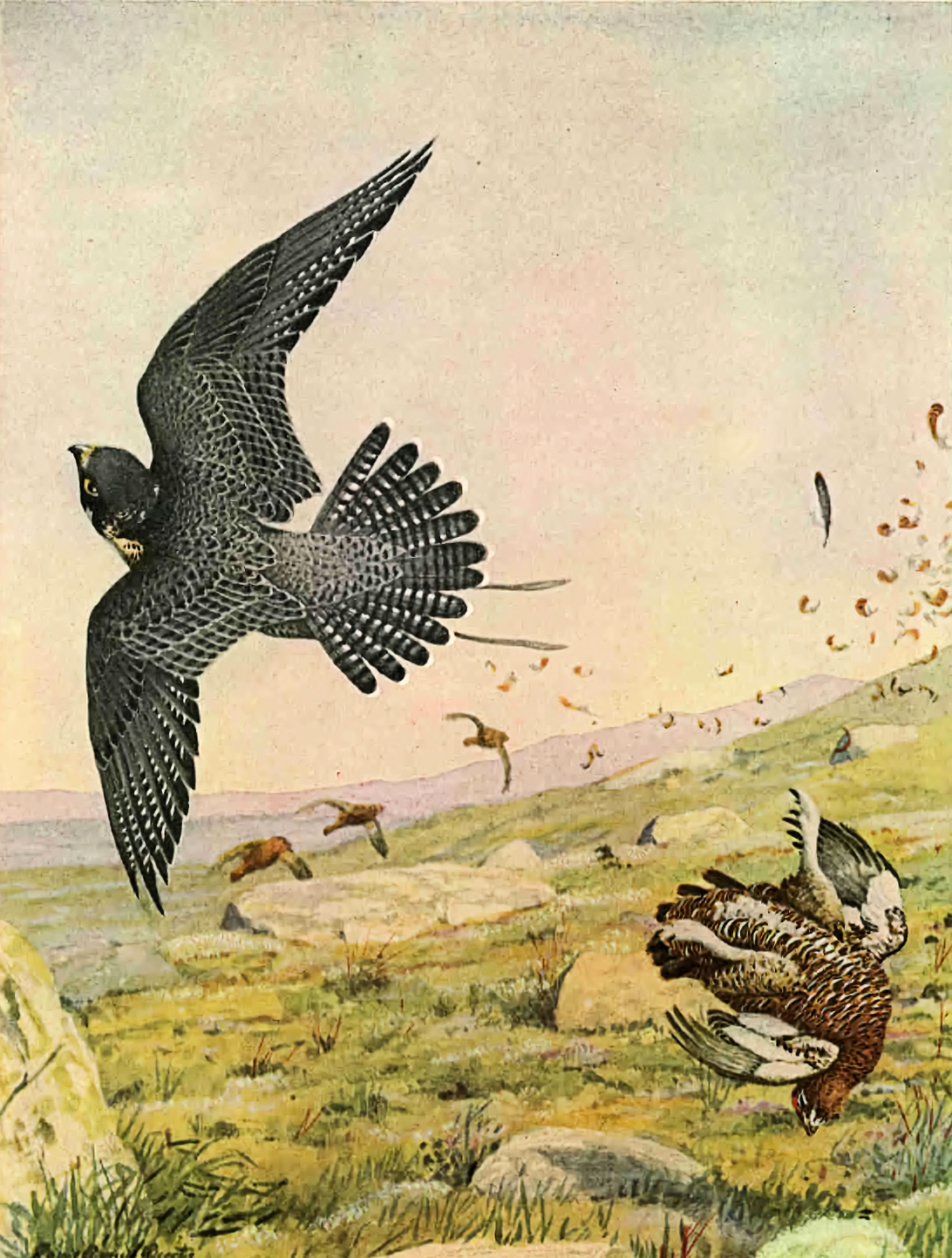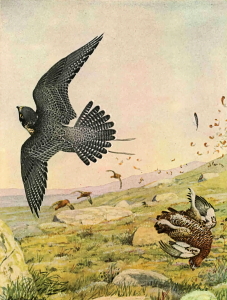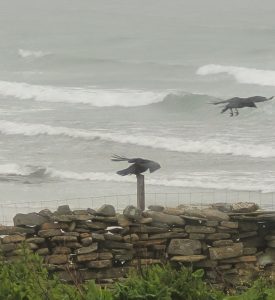
25/09/2024, by aezcr
The First Bird-Watcher on North Ronaldsay
Chapter 8 of the Saga of the Earls of Orkney contains a very well-known episode in which Turf-Einarr kills Hálfdan High-leg, one of the sons of King Haraldr of Norway who killed Einarr’s father, Earl Rǫgnvaldr of Møre in Norway. After a battle in an unspecified location, the victorious Einarr and his men scour the islands of Orkney for those who had fled the battle. On North Ronaldsay, Einarr spots something in that very flat island, and says:
‘I do not know what it is I see in North Ronaldsay, sometimes it lifts itself up, and sometimes it lays itself down. It is either a bird or a person, and I’ll go to it.’
I suppose this makes Einarr the first recorded bird-watcher on North Ronaldsay. Of course if you read the Penguin translation of Orkneyinga Saga, you will not discover where this episode happened since the translators chose not to include this information, though it is in several manuscripts of the saga. It is true that instead of the usual Old Norse name of the island Rínansey, the Flateyjarbók manuscript has Rínars hæð, ‘Rínar’s Hill’, a name not otherwise known from anywhere else but, on the basis of the manuscript stemma, unlikely to be what was in the original version of the saga. The Penguin translators do have problems with their Ronaldsays as, at the end of the same chapter, they translate Rǫgnvaldsey as ‘North Ronaldsay’, when it is in fact the usual Old Norse name for South Ronaldsay (as is clear from the mention of Hoxa in the same sentence).
The bird motif continues when Turf-Einarr has caught up with Hálfdan, let us say it was indeed in North Ronaldsay. In one of the more gruesome scenes of saga literature, he executes him in the following way:
‘There they found Hálfdan High-leg and Einarr had an eagle cut on his back with a sword and all the ribs cut from his spine and the lungs pulled out there and gave him to Óðinn for his victory.’
This ‘blood-eagle’ appears in various forms in Old Norse literature and many have assumed that it was a genuine form of execution in the Viking Age, even though it seems anatomically implausible. A recent article by Luke Murphy and others goes through the evidence in excruciating detail and concludes that this particular form of torture could have taken place within certain social and cultural parameters in the Viking Age but that it did not necessarily do so. Despite their judicious assessment of a very wide range of evidence, my own view is that it is more likely to be a literary development of the common motif in which the ‘beasts of battle’ (eagle, raven and wolf) feed on corpses after a battle. Indeed, this motif occurs in one of the stanzas that Einarr himself declaims after killing Hálfdan:
Þeygi dylk, nema þykki
— þar fló grár af sôrum
hræva nagr of holma —
hól undvala gœli.
I don’t deny the wound-falcon’s
gladdener thinks it’s a boast;
there the grey corpse-gnawer flew
past islets at the wounded.
[‘wound-falcon’ = ‘raven’ or ‘eagle’, its ‘gladdener’ = warrior; ‘corpse-gnawer’ = ‘eagle’]
Sadly, a bird-watching aficionado of the saga will find few references to birds there other than these rather gory kennings which are, however, quite frequent in the poetry, both in the saga and elsewhere. These are examples found in the verses cited in the saga:
Ravens at Nouster, North Ronaldsay.
‘wound-falcon’ = ‘raven’ or ‘eagle’, its ‘gladdener’ = warrior’
‘corpse-gnawer’ = ‘eagle’
‘Huginn’ = name of a raven, its ‘foot-reddener’ = ‘warrior’
‘battle-gull’ = ‘raven’ or ‘eagle’
‘raven-feeder’ = ‘warrior’
’wolf-sater’ = ’warrior’
‘wound-gosling’ = ‘raven’ or ‘eagle’, its ‘feeder’ = ‘warrior’
‘army-starling’ = ‘raven’, its ‘feeder’ = ‘warrior’
Kennings of this type are explained by Snorri Sturluson (trans. Faulkes 1987, 117) as follows:
There are two birds that there is no need to refer to in any other way than by calling blood or corpses their drink or food. These are the raven and the eagle. All other masculine birds can be referred to in terms of blood or corpses, and then it means eagle or raven…
Within these carrion-kennings we do find the Old Norse words for various birds:
‘falcon’ = valr
‘gull’ = már
‘raven’ = hrafn
’gosling’ = gagl
’starling’ = stari
There is one final bird-reference in the poetry of the saga. In chapter 94, Earl Rǫgnvaldr Kali Kolsson, no mean poet himself, is eluding his enemies when staying at one of his tenant farms at Knarston in Mainland. As the enemies start to catch up with him, his loyal man Bótólfr, an Icelandic poet, diverts the chasers by telling them that:
Ferr at foglum harri
— firar neyta vel skeyta —
— ván á heiðar hœna
hnakkadytts — und bakka.
Þar verðr almr, es olmir
undlinns stafir finnask
— land verr lofðungr brandi —
lynghœsn, dreginn kyngjum.
The lord has gone to hunt birds
beneath the slopes; men are using
shooting-weapons well; the hen of the
heath has expectations of a neck-blow.
The bow is being frequently drawn,
where the frenzied poles of the wound-serpent
and the heather-chicken meet;
the prince defends the land with his sword.
[‘wound-serpent’ = ‘sword’, its ‘poles’ = ‘warriors’]

Peregrine falcon striking a red grouse (Louis Agassiz Fuertes, Public domain, via Wikimedia Commons)
Of course Rǫgnvaldr was nowhere near the slopes or the heath, but had been hidden in the house by Bótólfr, and escapes to his estate at Orphir while his pursuers are on a wild chicken chase. But the stanza tells us that hunting game birds with a bow and arrow was a plausible thing for a twelfth-century earl to do. As to what kind of birds, we are only given two versions of the same kenning: ‘hen of the heath’ and ‘heather-chicken’. What kind of game-bird these refer to is not clear, but Red Grouse is a possibility; compare the Scottish term ‘Moor Fowl’ for the Red Grouse (Lockwood 1984). And once again we learn two bird words in Old Norse:
‘hen’ = hœna
‘hen’ or (as a collective noun) ‘poultry’ = hœsn
While the saga does not present us with many birdwatching opportunities, it is clear that the Norse inhabitants of Orkney knew their birds, many bird-words in Old Norse survived in the dialects of northern Scotland, and some in standard English. Here are just a few gleaned from Lockwood’s Oxford Book of British Bird Names:
Auk = alka
Chalder/Shalder (Oystercatcher) = tjaldr
Fulmar = fúlmár (lit. ‘foul gull’)
Gairfowl (Great Auk) = geirfugl
Hegrie (Heron) = hegri
Lyre (Manx Shearwater) = líri
Scarf ( Cormorant) = skarfr
Yogle (Owl) = ugla
Judith Jesch
(this blog was inspired by a stay at the North Ronaldsay Bird Observatory)
Further Reading
B. Lockwood, The Oxford Book of British Bird Names, 1984.
Snorri Sturluson, Edda, trans. Anthony Faulkes, 1987.
Previous Post
Crossing the Sea of OrcsNo comments yet, fill out a comment to be the first


Leave a Reply